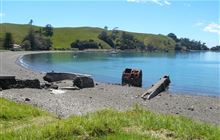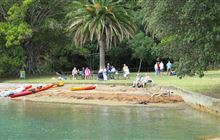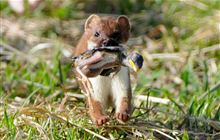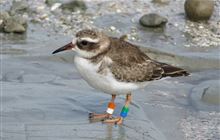Stoat incursion response underway on pest free Motutapu Island
Archived content: This media release was accurate on the date of publication.
Introduction
DOC, Ngāi Tai ki Tāmaki kaitiaki and Kiwis for kiwi are working together to catch a stoat on pest-free Motutapu Island.Date: 19 January 2021
The Department of Conservation (DOC), Ngāi Tai ki Tāmaki kaitiaki and Kiwis for kiwi are working together to catch a stoat on pest-free Motutapu Island in the Hauraki Gulf Marine Park, Tīkapa Moana, Te Moananui-ā-Toi.
The response comes after DNA evidence and a Massey University pathology report confirmed that a tūturuatu/shoreplover, found dead in its nest late last year, was killed by a stoat. Two other tūturuatu have since been found dead.
Operations Manager Kat Lane says it’s disappointing that there is another stoat on pest free Motutapu.
“Stoats pose a significant threat to the island’s biodiversity and we are devastated by the loss of tūturuatu.
“All three tūturuatu deaths were males killed at night while incubating their eggs. This has caused a disruption in our breeding pairs and is a serious setback for the Motutapu population which has struggled to establish.”
Earlier this month the trapping situation was assessed and advice provided to rangers. Conservation pest detection dogs were then deployed to detect stoat scent.
Trail cameras have been installed to monitor nests and DOC is working with Ngāi Tai ki Tāmaki to rebait and add additional traps to the extensive network of 350 DOC200 traps across both Motutapu and Rangitoto. Rangers will also monitor the tūturuatu population.
Ngāi Tai ki Tāmaki leader Billy Brown says, “Our ancient kaitiakitanga responsibilities to taonga species including manu and kawekaweau means we need to remain vigilant at all times to these types of incursions.”
Kiwis for kiwi executive director Michelle Impey says it was important to respond to the discovery as quickly as possible to reduce the likelihood of other wildlife succumbing to the stoat.
“There are many organisations and individuals who, alongside Kiwis for kiwi, have invested both emotionally and financially to grow the kiwi population on Motutapu Island. We are very keen for this stoat – and any others that might be on the island – to be caught.”
How the stoat has made its way onto the island is undetermined, however it is most likely that it swam.
This response follows a previous incursion, which saw a stoat trapped on Rangitoto on 25 September 2020. A dog search in early October indicated no further stoat presence, and the incursion response ended.
Kat Lane says, “This is a timely reminder to ensure that when heading out onto the Hauraki Gulf, you do thorough biosecurity checks of your boats and all of your gear/equipment. This includes not taking any pets onto island reserves. We must do everything we can to avoid risk of incursion and to protect our taonga species.”
Background information
Motutapu Island
Motutapu has been pest free since 2011 and provides a safe haven for threatened and at-risk native wildlife including kiwi, takahē, tūturuatu/shoreplover, tīeke/saddleback, kākāriki/red-crowned parakeet, korimako/bellbird, and native skinks.
At 178 million years old pest-free Motutapu is one of the oldest land masses in the Hauraki Gulf. The island was intensively settled by Māori, it hosted massive Victorian picnic parties, and was a base during WWll. Now, following the world’s largest island pest eradication programme, it’s a fine place to see native birds including the rare tieke. Ngāi Tai ki Tāmaki and DOC are focussed on restoring the mauri on the island through various initiatives.
Motutapu is one of 47 pest free islands in the Hauraki Gulf.
Visiting pest free islands
When visiting pest free islands or islands that are becoming pest-free, make sure you check your gear before you leave the mainland.
- Check – your gear for pests such as rodents and insects
- Clean – footwear and gear, removing soil and seeds
- Seal – ensure your gear is zipped up (no open bags)
When you arrive on a pest-free island, you may be met by rangers to recheck your gear. Dogs are not allowed on island reserves in the Bay of Islands, Hauraki Gulf, and Marlborough Sounds islands. Check specific rules for a place before you visit.
Stoats
Stoats are members of the mustelid family. Weasels and ferrets are also mustelids. All three species were introduced to New Zealand as early as 1879 to control rabbits that were destroying sheep pasture. From very early on, stoats have had a devastating effect on New Zealand’s unique birdlife.
The effect of stoat predation on the survival of many of New Zealand’s bird species cannot be underestimated. They are voracious and relentless hunters.
Tūturuatu/shore plover
The total wild shore plover population has 240 adult birds including 150 in the Chatham Islands. The only other ‘mainland’ site is Portland Island in Hawke’s Bay, which has almost recovered from a rat incursion in 2012.
Island biosecurity and predator incursions are a major concern for the shore plover recovery group. The group’s goal is to have five self-sustaining island populations by 2030.
Contact
For media enquiries contact:
Email: media@doc.govt.nz




